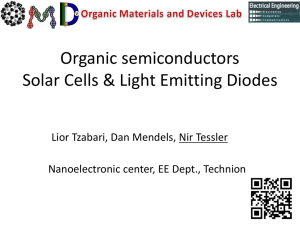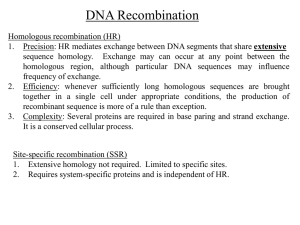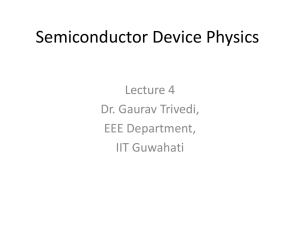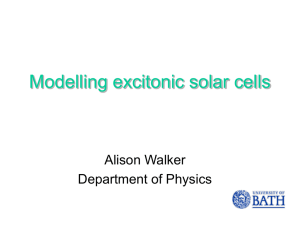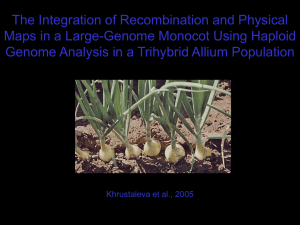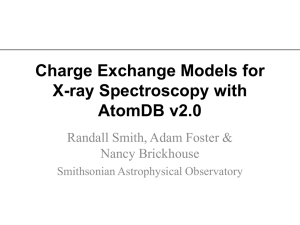dEt
advertisement
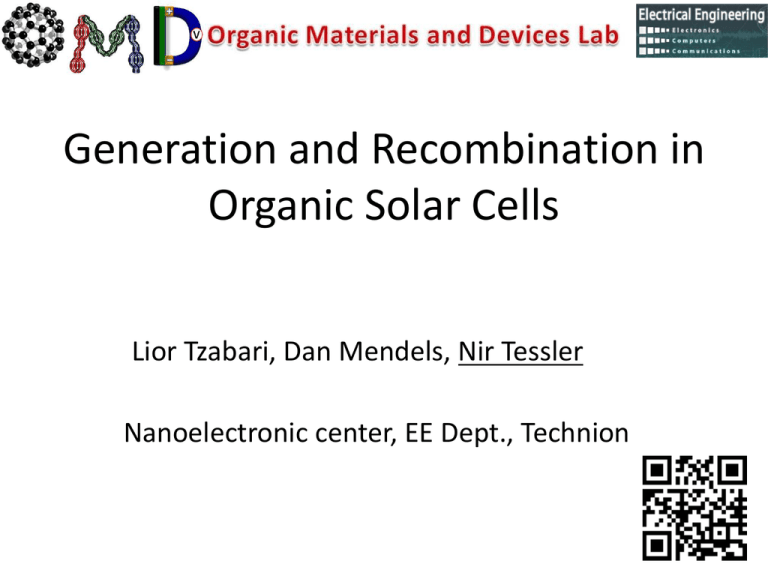
Generation and Recombination in Organic Solar Cells Lior Tzabari, Dan Mendels, Nir Tessler Nanoelectronic center, EE Dept., Technion Outline • Macroscopic View of recombination P3HT:PCBM - Exciton Annihilation as the bimolecular loss • Generalized Einstein Relation (one page) What about recombination in P3HT-PCBM Devices Let’s take a macroscopic look and decide on the relevant processes. What experimental technique would be best? Picture taken from: http://blog.disorderedmatter.eu/2008/06/05/ picture-story-how-do-organic-solar-cellsfunction/ (Carsten Deibel) Mobility Distribution Function or Spatially Dispersive Transport 1.2 1 Different time-scales 0.8 0.6 Different Populations 0.4 0.2 (PV is a CW device 0 -5 10 -4 10 2/ "Mobility" (cm Vsec) -3 10 N. Rappaport et. al., APL, 88, 252117, 2006 N. Rappaport et. al., JAP, 99, 064507, 2006 N. Rappaport, et. al., Phys. Rev. B 76 (23), 235323 (2007). L. S. C. Pingree, et.al., Nano Lett. 9 (8), 2946-2952 (2009). ) QE as a function of excitation power (If Undoped) Only Loss Mechanism Is Exciton recombination (Intra, Inter, “pairs”,…) Free-Charge Generation Efficiency HOMO Al Ca Cell Efficiency 0.55 0.5 0.45 0.4 Other Losses Kick in 0.35 0.3 0.25 0.01 0.1 1 10 100 Generating Power (mWcm-2) PEDOT:PSS ITO Glass N. Tessler and N. Rappaport, JAP, vol. 96, pp. 1083-1087, 2004. N. Rappaport, et. al., JAP, vol. 98, p. 033714, 2005. QE as a function of excitation power Langevin /Bimolecular loss A P J PC qe E n qh E p Je J n h p h e I L B np dq Charge generation rate Photo-current Smaller Bimolecular No re-injection Coefficient Bimolecular recombination-current Signature of bi-molecular Loss N. Tessler and N. Rappaport, Journal of Applied Physics, vol. 96, pp. 1083-1087, 2004. N. Rappaport, et. al., Journal of Applied Physics, vol. 98, p. 033714, 2005. QE as a function of excitation power LUMO Mid gap HOMO Doped Traps already filled RSRH Cn N t ne 1.05 1 2 0.95 0.9 1.6 0.85 1.4 0.8 Monomol 0.75 0.7 RSRH Et ne nh 2ni cosh kT 1.2 1 0.65 10-3 Intrinsic (traps are empty) Cn N t nh ne ni2 1.8 Bimolecular 10-2 10-1 100 101 102 103 2 Intensity [mW/cm ] Nt – Density of traps. dEt - Trap depth with respect to the mid-gap level. Cn- Capture coefficient L. Tzabari, and N. Tessler, Journal of Applied Physics 109, 064501 (2011) Loss Power-Law dEt Normalized Quantum Efficiency SRH (trap assisted recombination) loss QE as a function of excitation power LUMO Mid gap HOMO 1.05 Fewer Traps 1 0.95 2 1.8 0.9 1.6 0.85 0.8 1.4 0.75 1.2 0.7 Deeper Traps 0.65 10-3 10-2 10-1 1 100 101 102 2 Intensity [mW/cm ] L. Tzabari, and N. Tessler, Journal of Applied Physics 109, 064501 (2011) 103 Loss Power-Law Traps Normalized Quantum Efficiency SRH (trap assisted recombination) loss Recombination in P3HT-PCBM RLoss RLangevin q 2 min , n p n e h i Kb 4min 1 4 min Anneal Normalized QE 0.95 0.9 Kb[cm3/sec] 1.5e-12 Kb – Langevin bimolecular recombination coefficient In practice detach it from its physical origin and use it as an independent fitting parameter 0.85 0.8 0.75 0.7 0.65 , - Experiment , - Model 0.6 0.55 10 -2 10 0 Intensity [mW/cm2] 10 2 190nm of P3HT(Reike):PCBM (Nano-C)(1:1 ratio, 20mg/ml) in DCB PCE ~ 2% Recombination in P3HT-PCBM RLoss RLangevin K b np ni2 1 Kb[cm3/sec] 0.95 4 min Normalized QE 0.9 0.85 0.8 0.75 0.7 0.65 , - Experiment , - Model 0.6 0.55 10 -2 10 0 2 Intensity [mW /cm ] 10 2 4min 10min 1.5e-12 8e-12 Normalized Quantum Efficiency Shockley-Read-Hall Recombination LUMO 1.1 dEt 1 Mid gap 4 min 0.9 HOMO 0.8 0.7 0.6 Intrinsic (traps are empty) , - Experiment - Model , 0.5 -2 10 -1 10 0 10 RSRH 1 10 2 10 3 10 Cn N t nh ne ni2 Intensity [mW/cm^2] I. Ravia and N. Tessler, JAPh, vol. 111, pp. 104510-7, 2012. (P doping < 1012cm-3) L. Tzabari and N. Tessler, "JAP, vol. 109, p. 064501, 2011. Et kT ne nh 2ni cosh Shockley-Read-Hall + Langevin The dynamics of recombination at the interface is both SRH and Langevin Nt [1/cm3] dEt [eV] Kb[cm3/sec] 1 4min 1.9e17 0.435 0.5e-12 10min 1.2e17 0.371 0.5e-12 Normalized QE 0.9 0.8 0.7 0.6 , , 0.5 10 -2 LUMO - Experiment - Model 10 Mid gap dEt 0 Intensity [mW/cm2] 10 2 HOMO Exciton Polaron Recombination M. Pope and C. E. Swenberg, Electronic Processes in Organic Crystals., 1982. Neutrally excited molecule (exciton) may transfer its energy to a charged molecule (electron, hole, ion). As in any energy transfer it requires overlap between the exciton emission spectrum and the “ion” absorption spectrum. Quenching of Excitons by Holes in P3HT Films A. J. Ferguson, N. Kopidakis, S. E. Shaheen and G. Rumbles, J Phys Chem C 112 (26), 9865, 2008 Generated Charge Density (at t=0) In neat P3HT ramping the excitation power results in exciton-exciton annihilation Add 1% PCBM and losses become dominated by Exciton-Polaron recombination. Kep=3x10-8 cm3/s Excitation Density Exciton Polaron Recombination G nex K d V K ep nex n pl Normalized Quantum Efficiency Exciton-polaron recombination rate nex ex 1.1 1 4 minutes 0.9 4min 10min Nt [1/cm^3] 1.9e17 1.05e17 dEt [eV] 0.435 0.365 Kep[cm^3/sec] 1.6e-8 1.6e-8 0.8 10 minutes 0.7 0.6 0.5 -2 10 , - Experiment - Model , -1 10 0 10 1 10 2 10 Intensity [mW/cm^2] 3 10 Nt – Density of traps. dEt - trap depth with respect to the mid-gap level. Kep – Exciton polaron recombination rate. Kd– dissociation rate 1e9-1e10 [1/sec] A. J. Ferguson, et. al., J Phys Chem C, vol. 112, pp. 9865-9871, 2008 (Kep=3e-8) J. M. Hodgkiss, et. al., Advanced Functional Materials, vol. 22, p. 1567, 2012. (Kep=1e-8) Normalized Quantum Efficiency Traps or CT states are stabilized during annealing 1.1 1 4 minutes 0.9 0.8 0.7 10 minutes 4min 10min Nt [1/cm^3] 1.9e17 1.05e17 dEt [eV] 0.435 0.365 Kep[cm^3/sec] 1.6e-8 1.6e-8 0.6 0.5 -2 10 -1 10 0 10 1 10 2 10 3 10 Intensity [mW/cm^2] T. A. Clarke, M. Ballantyne, J. Nelson, D. D. C. Bradley, and J. R. Durrant, "Free Energy Control of Charge Photogeneration in Polythiophene/Fullerene Solar Cells: The Influence of Thermal Annealing on P3HT/PCBM Blends," Advanced Functional Materials, vol. 18, pp. 4029-4035, 2008. (~50meV stabilization) What does it all mean (summary, conclusions,…) 1. The “geminate” recombination occurs through “defect sites” and their availability limits the recombination. 2. “Defect sites” or “Traps” act like stabilized charge transfer states. 3. At high enough density (depending on morphology) a new channel opens up and Losses become Bi-molecular. 4. Bi-molecular = electron-hole or exciton-polaron? 5. Charge generation requires some field and this is observed at very low light intensities Disordered hopping systems degenerate semiconductors Y. Roichman and N. Tessler, APL, vol. 80, pp. 1948-1950, Mar 18 2002. Degenerate To describe the charge density/population one should use Fermi-Dirac statistics and not Boltzmann Degenerate (gas) It’s effect is in basic thermodynamics texts. White Dwarf Degenerate (gas) Pressure Astronomy: Degenerate gas pressure. Fluidics: Osmosis Pressure = Enhanced Diff. V n T P Drift Diffusion Seebeck Streaming In Semiconductors: D. Mendels and N. Tessler, J. Phys. Chem. C 117 (7), 3287-3293 (2013). Enhanced Diffusion Thank You Ministry of Science, Tashtiyot program Helmsley project on Alternative Energy of the Technion, Israel Institute of Technology, and the Weizmann Institute of Science Israeli Nanothecnology Focal Technology Area on "Nanophotonics for Detection" 21 Charge recombination is activated Cn Nt (V ) Applied Voltage [V] 0.2 0.1 0 -0.1 -0.2 1.2 n t Normalized C N / 1.3 1.1 1 0.9 0.8 0.7 0.6 0.5 0.3 0.4 0.5 0.6 0.7 Internal Voltage [V] 0.8 Why Generalized Einstein Relation does not affect the Ideality Factor of PN Diode Long Diode [N. Tessler and Y. Roichman, Org. Electron. 6 (5-6), 200-210 (2005)] Ie qAn0 τe DeVA e e e 1 De e In Amorphous semiconductors: e n e n f _ long eVA De 2 2 D kT q Exponential DOS Short Diode [Y. Vaynzof, Y. Preezant and N. Tessler, Journal of Applied Physics 106 (8), 6 (2009)] n f _ short 1 n f _ long T0 1; T 2 1 T / T0 n f _ short 1 T0 T
